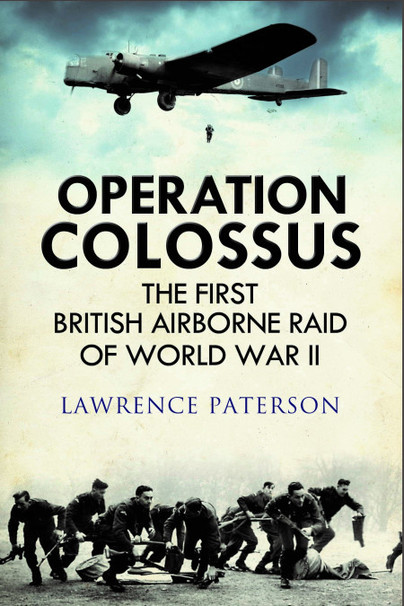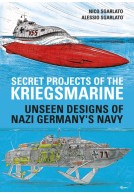Operation Colossus (Hardback)
The First British Airborne Raid of World War II

Pages: 256
Illustrations: 60 black and white
ISBN: 9781784383787
Published: 3rd April 2020
(click here for international delivery rates)
Need a currency converter? Check XE.com for live rates
| Other formats available - Buy the Hardback and get the eBook for £1.99! | Price |
|---|---|
| Operation Colossus ePub (28.6 MB) Add to Basket | £6.99 |
‘Paterson’s groundbreaking book is a detailed examination of the before, during and after of the now legendary Operation Colossus, the first British airborne raid of World War II’ - The Bookseller
Operation Colossus took place in Basilicata, Italy on 10 February 1941.
Britain was one of the last major powers of the Second World War to establish an airborne arm of service. Formed by a collection of free-thinking army and air force officers, the fledgling British paratrooper unit, known as the ‘SAS’, deployed trial and error in terms of tactics and equipment, costing the lives of several volunteers before an elite few were selected to make the first British parachute raid of the war. Alongside the paratroopers were two veterans of the First World War: an Italian SOE agent, formerly a banqueting manager in London hotels, and an RAF reserve officer who held the Military Cross for bravery.
Collectively known as ‘X-Troop’, these men were parachuted by specially selected bomber crews into the heart of enemy territory, where they successfully destroyed their target, the Tragino Aqueduct, before becoming the object of an exhaustive manhunt by Italian troops and civilians. Captured, they were variously interrogated, imprisoned, and the Italian SOE agent placed on trial for treason and executed.
Given the distances that had to be covered, the logistical complications and the lack of any precedent, the raid was a remarkable feat. Its success or failure depended on a group of men using methods and equipment thus far untried by the British Army. They were truly ‘guinea pigs’ for those that would follow in their footsteps.
Often overlooked in British military history, Paterson brings this extraordinary episode to light, drawing on verbatim testimony and interrogating the truth of previous accounts. From the formation of the unit and the build up to its first deployment, through Operation Colossus and its aftermath, to its ongoing legacy today, this is the fascinating story of the modern day British Parachute Regiment.
...this story will remind readers of the consequences of inadequate mission planning and commandand- control shortcomings. Furthermore, detailed accounts of the British paratroopers’ actions after the attack on the aqueduct should fascinate those seriously interested in survival, evasion, resistance, and escape (SERE).
Air Power History
Operation Colossus, The First British Airborne Raid of World War ll by Lawrence Paterson, is a remarkable, well researched story. Easy to read and a page turner, overshadowed by larger operations later in the war. Its legacy today is The Parachute Regiment.
Richard Gough, Military author and historian
… it’s an interesting read.
The Armourer, April 2021
An interesting and promising book.
Miniaturas JM
Read the full Spanish review here
Operation Colossus is a fascinating story worthy of a book, and Paterson’s diligent research honours the event and the men who took part. He uses sources as close to the action as he could get and that, along with his informative biographical details, personalises what could have been a humdrum operational report about a small action in a great war. Paterson also highlights the logistical and planning difficulties of staging a joint operation without glossing over the many mistakes that were made. Operation Colossus therefore achieves its goals and World War II readers will no doubt enjoy reading it.
Beating Tsundoku
Read the full review here
This is a little told story of the first British airborne forces that were to prove so useful that they rapidly grew in size and viable roles. The impact of Churchill was immediately felt when he became Prime Minister, a whirlwind of activity and aggression, he encouraged the development of new forms of warfare – Very Highly Recommended.
Firetrench
Read the full review here
This is a recommended work covering the seminal days of parachute troops within the British army and their first deployment with a stunning lack of foresight by those in senior positions letting down greatly the brave and resourceful early paratroopers.
Robert Bartlett
The Tragino Aqueduct raid in February 1941 marked the first airborne operation carried out by the British, with three dozen men parachuting deep into Italy to disrupt the water supplies to the ports of Bari, Brindisi and Taranto. Although their mission was a success, the damage was swiftly repaired and the entire party were captured along the daunting 50 mile escape route to the coast, yet the raid demonstrated what these troops could achieve and laid the groundwork for the ambitious operations of the following years. Despite a vast library of airborne literature and the importance of Operation Colossus in that story, relatively little has been written about it, and without doubt Paterson's very well researched account is the most authoritative to date. With the force barely six months old and struggling for resources, it describes the ad hoc preparations, and, with the aid of official reports and first hand accounts, reveals the enormous logistical challenges involved, followed by a thorough account of the raid itself, and the numerous escape attempts which followed, several of which were ultimately successful, before delving into the difficult business of analysing what the operation actually achieved.
Pegasus Archive
See the full review here
Operation Colossus does many things well. It provides an excellent overview of the development of parachute troops as well as an exciting battle narrative and gripping human interest story about men daring to strike a blow in the face of long odds. The book contains sufficient detail that knowledgeable readers will most likely learn something new, while readers new to reading about the war will not feel overwhelmed by jargon.Operation Colossus is a superb addition to the body of literature on airborne forces in World War Two.
Argunners
Read the full review here
This book is a very good and extremely detailed book with an awful lot of research been put into it. It was a read, which had me hooked from the beginning to end. Another thing that makes this book a good read is that it has interviews and information from the men who were actually on the raid. The book also gives you an insight into what each soldier got up after the event, which is always good to find out about. Overall this is an excellent read and credit has to go to the author Lawrence Patterson and entertaining and detailed read.
UK Historian
Read the full review here
Lawrence Paterson’s book is an incredible story beautifully told. As fiction it would be barely believable but the thoroughly researched facts are from official reports and first hand accounts. This book is about so much more than operation Colossus because it necessarily has to include the beginnings of military parachuting. Anyone familiar with modern military parachuting will be amazed by the early efforts in exiting from unsuitable aircraft. In a sense Colossus was an operation both to try out and test this new weapon in Britain’s armoury. From the missions successes and failures many useful lessons were learnt but to say more would be to give the game away and this book should be read as a novel which shouldn’t be spoilt by knowing the end before reading it. Supporting the text is a very good set of photographs.
Clash of Steel
To those who want to be better informed and to anyone who wants a good read we highly recommend this book.
Read the full review here
The book is well written with not too much jargon to confuse the non-military expert reader. I personally enjoyed this and would recommend it as a good read.
Army Rumour Service (ARRSE)
Read the full review here
Paterson's book is read with extreme pleasure, and as an Italian I can say that I do not find big errors in the names given (perhaps only the repetition of the acronym MSVN in place of the correct one MVSN). The book is passionate and is very well written, shedding light on an operation that is not very important perhaps for the results obtained, but of extreme value for the ability of the British military authorities to improve and learn from the errors.
On The Old Barbed Wire
Read the full Italian review here
A featured onWW2 Talk
WW2 Talk
Rating: 5 out of 5 stars
NetGalley, K Manley
This book sets out to provide an account of an early special forces operation that involved parachuting commandos into southern Italy in 1941 and succeeds admirably in describing the difficulties encountered in establishing a viable air-inserted special forces team, complete with arms, equipment and explosives, behind enemy lines. It highlights the many false starts and the lack of preparedness of the Commando teams at this early stage of the war and the way in which the lessons learned were used to ensure that the Airborne Forces deployed later in the war were better prepared for the difficulties likely to be encountered. However, many readers will share the author’s - and this reader’s - disappointment that a number of key lessons had still not been addressed by the time the Rhine crossing was attempted at Arnhem in 1944, particularly in respect of reconnaissance and deployment of troops as close to the objective as possible.
The writing is well-paced and skilfully weaves together a range of first person accounts to convey a coherent account of the recruitment, training and deployment of the troops, including their subsequent successful completion of their mission. The narrative continues with the troops’ attempts to make their way to the coast to where they believed a submarine would be waiting on prearranged nights. The decision by the planners to cancel this rendezvous fortunately did not add to the problems experienced by the Commandos as they were all caught as they made their way to the coast. The account is all the better for the lack of any chauvinistic flavour to the writing and for the factual, rather than any ‘gung ho’, sentiment.
For this reader, the later section of the book that deals with the ‘what happened next’ to the Commandos after capture and imprisonment was a little lengthy and occasionally repetitive. However, this did not detract from the overall high quality of the book, which served as a reminder of the incredible heroism of the many young, and not so young, men who volunteered for exceptionally hazardous duty.
Rating: 5 out of 5 stars
NetGalley, Victoria Watson
Wonderfully written story. Recommend it if you like learning about WWII I liked the book. It gave me facts I didn't know about that time period.
About Lawrence Paterson
Lawrence Paterson has written several books on various aspects of the U-boat war, including U-Boat War Patrol, Weapons of Desperation, Hitler's Grey Wolves, Hitler's Brandenburgers and a biography of Otto Kretschmer. He lives in Taranto, Italy and is drummer in a heavy metal band.




















